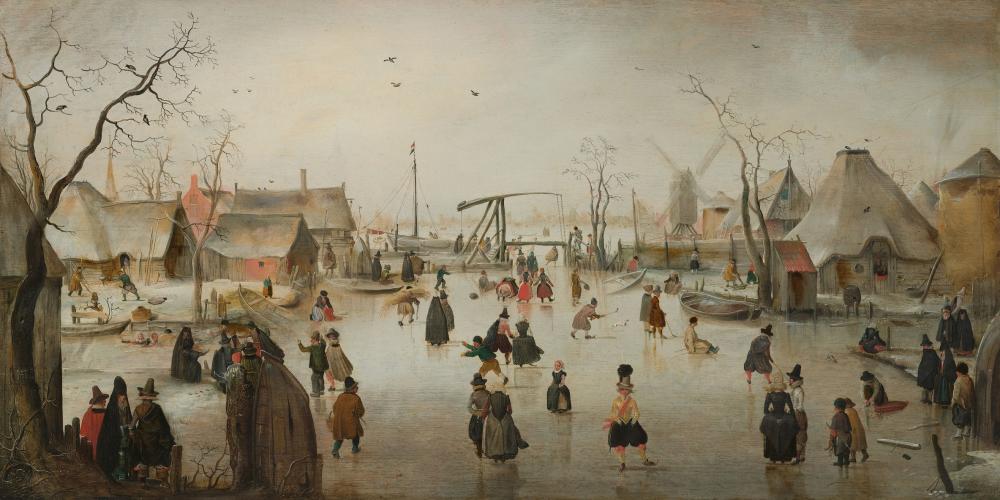
The VUB turned the thermostat down a few degrees, but didn't people in the Middle Ages suffer much more from the cold?
"People were much more dependent on the weather than now. We live in insulated houses, always have food available and wear warm clothes. But for medieval people, cold was a real threat, so they were also constantly dealing with it. You can see that in texts and plays. These often dealt with a struggle between winter and summer. In the farces, they laughed at dimwits who did not prepare for winter, who were given names like Klappertand and Druipneus.
But it was not all doom and gloom. People skated on the ponds as entertainment and in the late Middle Ages snow parties were organised. Historian Herman Pleij describes the snowmen of the snow festival in Brussels in his book The Snowmen of 1511. "That amounts to figures such as Hercules with his mace and lion skin, the blowing Roeland, a fighting elephant, fools, a kind of Manneken Pis, naked lovemaking lovers, a voluptuous whore, the male of in moon, a diarrhoeic drunkard, and so on about a hundred more dolls." People lived to the rhythm of the seasons."
What did the climate look like?
"You can't speak of a climatically uniform era. The Middle Ages covers a long period from 500 to 1500. For the first four to five hundred years, it was one to two degrees colder than it is today. From 950 AD, it then got warmer again, with temperatures similar to ours, possibly even slightly higher. This warming increased agricultural production and wine was grown as far away as England. It was also the period when the Vikings swarmed all over the world, mainly because there was less ice formation in the North Atlantic and they also found good agricultural land there, as far away as Greenland and Newfoundland.
Then came the Little Ice Age at the end of the Middle Ages. We were not under an ice sheet then, but the temperature was lower, about 1 to 2 degrees compared to now. This period ran until the end of the 19th century. The coldest decades were in the late 16th century and early 17th century. Those are also the years when painters like Pieter Breughel The Elder and Hendrick Avercamp put the famous winter landscapes on canvas."
"It is important to realise that this was not a global process. Rather, the cold and warm periods were regional phenomena."
How do historians know what the temperature was?
"To find out the temperature of a particular period, we don't just use historical written sources. These are often not representative or reliable. A monk can write about ice in March, but how far was it from the coast? And did it apply to the whole region? To get a reliable picture, the annual rings of trees are studied, for instance. You can tell from the thickness of a layer whether it was a heavy year or not. Ice samples from different parts of the world can also tell a lot about climate. That makes historical research on weather a very interdisciplinary story."
Were the summers very hot and the winters very cold?
"They were very recognisable seasons. We can see that in the many calendars and tide books, which have characteristic pictures for each month. In the winter months, you had snowfall, freezing temperatures and people sat inside. In spring, life resumed. And in summer, life took place outside with feasts and harvests. In autumn, people retreated again."
How did they keep warm?
"By far the main fuel was firewood and exceptionally peat, if they lived in right region. Sometimes fuel was organised collectively. Villages had common land with a patch of forest where residents could gather their firewood for their own hearth. That hearth occupied a central place in their homes around which a lot of social life took place."

En bij professor Bart Lambert thuis in de 21e eeuw.
What measures have you taken?
"I am one of the lucky ones with a fixed energy contract. That saves a lot. But still there is a lot to do. We just moved into a house from the 1960s, where the insulation could still be improved."
What adjustments have you made at work?
"At work, I do whatever medieval people did: I dress with as many woollen layers as possible."
Did they have houses that could keep them warm?
"Most people lived in the countryside. They had houses constructed from wickerwork of tree branches with loam smeared on top. Not ideal for retaining heat. They lived together in larger family groups than we know today. So cousins, uncles and aunts could live in, for example. For much of the Middle Ages, they lived together not only with relatives, but also with animals: sheep, goats, pigs, cows. Don't imagine too large a herd of livestock and forget about hygiene, but the animals did make it warmer indoors."
"In the cities, the houses were made of wood. That made them very fire-prone, especially in combination with the central fireplace. Consequently, houses or even entire city districts regularly went up in flames."
"The plague (1347-1352) changed this because - how ironic - it brought more prosperity. During this epidemic, possibly even half of Europe's population died. As a result, the price of labour rose, allowing more and more people to afford better housing. Especially in the course of the 15th century, you can see that more and more houses in the city were built mainly of stone at the bottom.
How did they dress?
"They didn't have synthetic fabrics, of course. Most of the population wore woollen clothes. Depending on the weather, they had several layers on: linen underneath - especially against the prickling of the wool - over that one or more layers of wool. The elite distinguished themselves by also wearing fur and silk. In addition, they wore hats, caps and gloves, we have learnt from pictures and excavations. Those gloves were strange: they were mittens with only room for the thumb separately or they consisted of three parts, one for the thumb and two for the four fingers. We don't actually know why they made them that way."
Did people die of cold?
"In the chronicles, it is mentioned that people died of hypothermia: the poor, travellers, the elderly. But indirectly, many more died because of low temperatures, because a prolonged cold caused famines. Crops had a shorter period to grow and be harvestable. Plants even rotted more easily because it was more humid.
Between 1315 and 1317, you had several cold years in a row that caused a lot of misery. A cold and wet spring and summer caused a very poor harvest. Even cattle were affected by a massive cattle death. This disaster affected the whole of north-western Europe. Probably the biggest famine of the Middle Ages. In some cities, ten per cent of the population died. In Ypres, a town of some twenty-five thousand inhabitants, during six months in 1316, nearly 2,800 people were buried at the town's expense. Famines like this due to extreme weather conditions were a regular occurrence."
Did administration or churches offer help?
"A discontented population is dangerous, especially in the city. So in frugal times, measures were taken so that citizens could stay warm. Brussels distributed firewood, for instance. The church also saw a big role for itself here and organised armdishes all year round. Aid was provided locally by local governments. Central governments hardly played a role in it, unlike in our times."